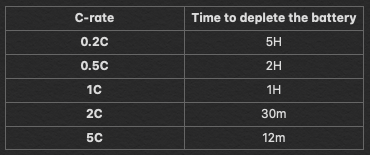Things to consider when buying an #EV
Most of the EVs these days utilized the Li-ion battery in their battery packs. (Some older hybrid models have Nickel Metal Hydride, like Toyota Prius Gen 3). New cars like Tesla S3XY, Chevy Bolt, Hyundai Ioniq, Kona, Nissan Leaf and BMWi3 all use Li-ion battery as their battery pack. Today we are going to discuss one of the important factor when selecting EV: Battery Capacity
The bigger the battery, longer the usable range it has (Yea, sounds about right). But what most of the people doesn’t know is that the battery capacity will affect the discharge rate (C-rate) of a car, and that will heavily affect the usable capacity, battery life, battery efficiency and so on.
According to Wikipedia;
The C-rate is a measure of the rate at which a battery is being charged or discharged. It is defined as the current through the battery divided by the theoretical current draw under which the battery would deliver its nominal rated capacity in one hour. It has the units h−1. [1]
- C-rate vs Capacity vs time of discharge
Let’s look at this table
C-rate Time to deplete the battery

Table 1: C-rate versus discharge time for a given capacity.
The time to fully discharge a battery depends highly on the discharge C-rate. This number is theoretical and the number should vary. Lower C-rate can actually produce more capacity than the battery was rated, that means the 0.2C discharge can actually last longer than 5 hours. On the other hand, the 5C discharge rate should last less than 12m. This can be shown in the figure below from Battery University:

Figure 1: Battery will be fully discharged under an hour with 1C discharge rate, while it will go over 5 hours with (1/5C) 0.2C. so with lower C-rate, the battery actually produce more than 100% rated capacity. [2]
So the battery discharge rate vs time is not linear.
So now we know that C-rate vs time of discharge is not linear. The non-linearity is actually caused by the change in capacity with different discharge rate as shown in Figure 2:

Figure 2: The higher C-rate that you discharge, the lower the battery capacity. [3]
- C-rate vs battery life in long term:
Imagine you drive a car to work every day with 50miles round trip: Let’s assume the car draws 20kWh constantly every hour @ 50miles/hour.
You will send one hour on the road, and you will use 20kWh of energy for the trip.
a. Scenario 1: your car’s battery capacity is 30kWh
20kWh = 66.6% depth of discharge of the battery every day. (You will arrive home at battery level of 33.33%)
You will discharge constantly (10kWh) at 0.66C for the trip.
b. Scenario 2: your car’s battery capacity is 60kWh
20kWh = 33.33% depth of discharge of the battery everyday. (You will arrive home at battery level of 66.66%)
You will discharge constantly (10kWh) at 0.33C for the trip.
**( the 60kWh battery capacity will add weight to the car and hence will draw more than 10kWh to run at constant 50miles/hour but for the ease of calculation we rule that out at this point)
See the different on the above scenarios? scenario 1 will shorten your battery life tremendously in the long term. A chart from battery university is very useful to explain the effect of depth of discharge of the battery at a constant discharge rate (Figure 3)

Figure 3: Capacity loss as a function of charge and discharge bandwidth.*
Charging and discharging Li-ion only partially prolongs battery life but reduces utilization.[4]
Case 1: 75–65% SoC offers longest cycle life but delivers only 90,000 energy units (EU). Utilizes 10% of battery.
Case 2: 75–25% SoC has 3,000 cycles (to 90% capacity) and delivers 150,000 EU. Utilizes 50% of battery. (EV battery, new.)
Case 3: 85–25% SoC has 2,000 cycles. Delivers 120,000 EU. Uses 60% of battery.
Case 4: 100–25% SoC; long runtime with 75% use of battery. Has short life. (Mobile phone, drone, etc.)
Courtesy: ResearchGate – Modeling of Lithium-Ion Battery Degradation for Cell Life Assessment.
https://www.researchgate.net/publication/303890624_Modeling_of_Lithium-Ion_Battery_Degradation_for_Cell_Life_Assessment
In summary, battery capacity is one of the important factor to consider when come to EV. Of course, the rate of dischargeis affected by the battery capacity and also how much current is drawn by the motor, and the current drawn is heavily affected by the weight of the car, the coefficient of drag, efficiency, temperature and a lot more. We will discuss more in the next post.
Cheers
Reference:
Congratulations @newergy! You have completed the following achievement on the Steem blockchain and have been rewarded with new badge(s) :
You can view your badges on your Steem Board and compare to others on the Steem Ranking
If you no longer want to receive notifications, reply to this comment with the word
STOPVote for @Steemitboard as a witness to get one more award and increased upvotes!